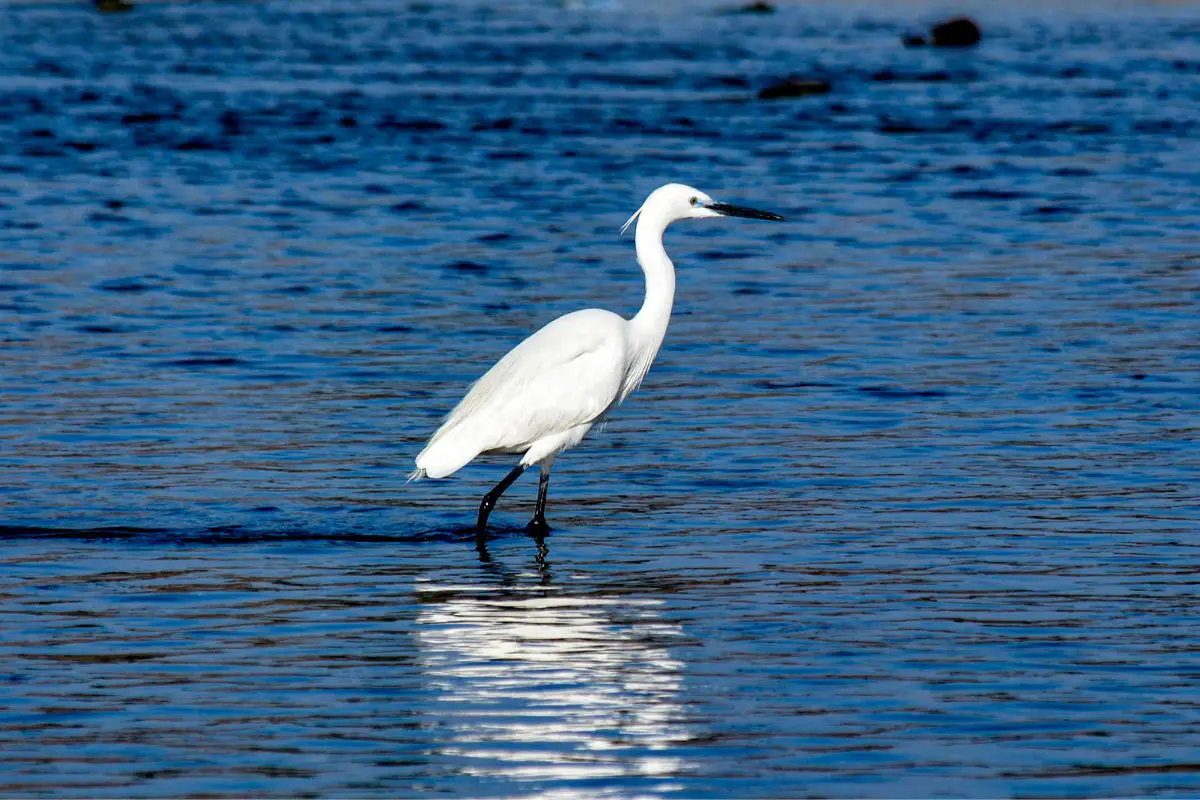
When you see a bird soaring high in the sky, its long neck and legs trailing behind it, you might mistake it for a crane. But which birds really do look like cranes? Here are the top 17 birds that look strikingly similar to these tall wading birds!
What is a Crane?
Before we can dive in to look at some of the doppelgängers of cranes, let’s first establish what defines a crane. Cranes are a family of large, tall wading birds with long necks, legs, and bills. They can be found on every continent except for South America and Antarctica, making them one of the most widespread bird families in the world.
There are 15 species of crane, divided into 4 genera:
- Grus (9 species)
- Antigone (4 species)
- Balearica (1 species)
- Garrulax (1 species).
The best known member of the crane family is probably the whooping crane (Grus Americana), which is the tallest bird in North America. These birds are iconic symbols of grace and longevity, and have been revered by cultures around the world for centuries. In fact, the crane is the national bird of several countries, including Japan, China, and Korea!
What Does A Crane Look Like?
Now that we know a bit more about cranes, let’s take a closer look at what sets them apart from other birds. Cranes are generally quite large, with most species ranging from 1.5-2.5 m (4.9-8.2 ft) in height. Their long necks can range from 50-140 cm (20-55 in) in length, and their legs can be nearly as long as their bodies!
This gives them a very distinctive silhouette, which is often the first clue that a bird might be a crane. Cranes also have large, powerful bills, which they use to feed on a variety of foods including insects, small mammals, and reptiles. Their bills are often brightly colored, and can be used to help identify different crane species.
Finally, cranes are excellent flyers, and are known for their soaring migrations. This means that they often have long wingspans, which can range from 2-3 m (6.6-9.8 ft)!
What is the Crane’s habitat?
Cranes can be found in a variety of habitats, including wetlands, grasslands, and even mountains! They often build their nests near water, which is essential for their survival. Wetland habitats are particularly important for cranes, as they provide the perfect place for these birds to find food and mate.
Wetlands also offer protection from predators, and can help cranes stay cool in hot weather. Grassland habitats are also popular with cranes, as they provide plenty of open space for these large birds to stretch their wings. Cranes often nest in grasslands, and use these areas to raise their young.
Finally, some crane species can be found in mountainous habitats. These birds use their long legs to help them navigate through snow and ice, and build their nests on rocky cliffs.
What is the Crane’s diet?
Cranes are omnivorous birds, which means that they eat both plants and animals. Their diet varies depending on the habitat in which they live, but typically includes a mix of insects, small mammals, reptiles, and even fish. Cranes use their long bills to help them forage for food, and will often cooperate with other cranes to help find a meal.
In fact, some crane species have been known to form “feeding parties” of up to 100 birds!
How Does a Crane Reproduce?
Cranes are monogamous birds, which means that they mate for life. Once a pair of cranes has found each other, they will perform a series of elaborate courtship dances to solidify their bond. These dances often involve the cranes bowing, leaping, and calling out to each other.
They may even build a “nest” out of sticks and twigs, which they will use to incubate their eggs. Cranes typically lay 2-4 eggs at a time, which the parents take turns incubating. The eggs hatch after about 30 days, and the chicks are cared for by both parents.
The young cranes learn to fly at around 3-4 months old, and become fully independent shortly thereafter.
What is the Crane’s lifespan?
Cranes are long-lived birds, with a typical lifespan of 20-30 years in the wild. However, some crane species have been known to live for over 50 years! In captivity, cranes can live even longer, with an average lifespan of 40-50 years.
One captive crane even lived to be over 80 years old!
What are the Crane’s predators?
Cranes have a variety of predators, including wolves, foxes, coyotes, and even eagles. These animals often prey on crane eggs and chicks, which are vulnerable to predation. Adults cranes are less likely to be targeted by predators, but can still fall victim to attacks.
Cranes typically defend themselves by using their powerful bills and sharp claws to fight off their attackers. Now that we’ve established what a crane is, let’s take a look at some of the most popular crane look-alikes.
1. American White Pelican

The first on our list is the American white pelican, which is a large bird that can be found in North America. These birds are similar to cranes in a few ways, including their size, long bills, and webbed feet. However, there are also some key differences between the two species.
For example, American white pelicans have white plumage, whereas cranes are typically a gray or brown color.
What Does An American White Pelican Look Like?
The American white pelican is a large bird that can be found in North and South America. These birds have white plumage, black wingtips, and a yellow bill. They are one of the largest birds in North America, with a wingspan of up to 12 feet!
What is the American White Pelican’s habitat?
The American white pelican typically inhabits coastal areas, such as lakes, marshes, and estuaries. These birds use their long bills to scoop up fish from the water. They are also known to eat amphibians, reptiles, and invertebrates.
What is the American White Pelican’s diet?
American white pelicans are carnivores, and their diet consists mainly of fish. They use their long bills to scoop up fish from the water. They are also known to eat amphibians, reptiles, and invertebrates.
How Does an American White Pelican Reproduce?
American white pelicans typically mate for life. The female lays 2-3 eggs in a nest made of sticks, which is usually built on the ground. Both parents help to incubate the eggs, which hatch after about 30 days.
The chicks are altricial, meaning they are born helpless and require care from their parents.
What is the American White Pelican’s lifespan?
The average lifespan of an American white pelican is 15-20 years in the wild.
What are the American White Pelican’s predators?
The main predators of American white pelicans are birds of prey, such as eagles and hawks. Other predators include foxes, raccoons, and snakes.
2. Eurasian Spoonbill
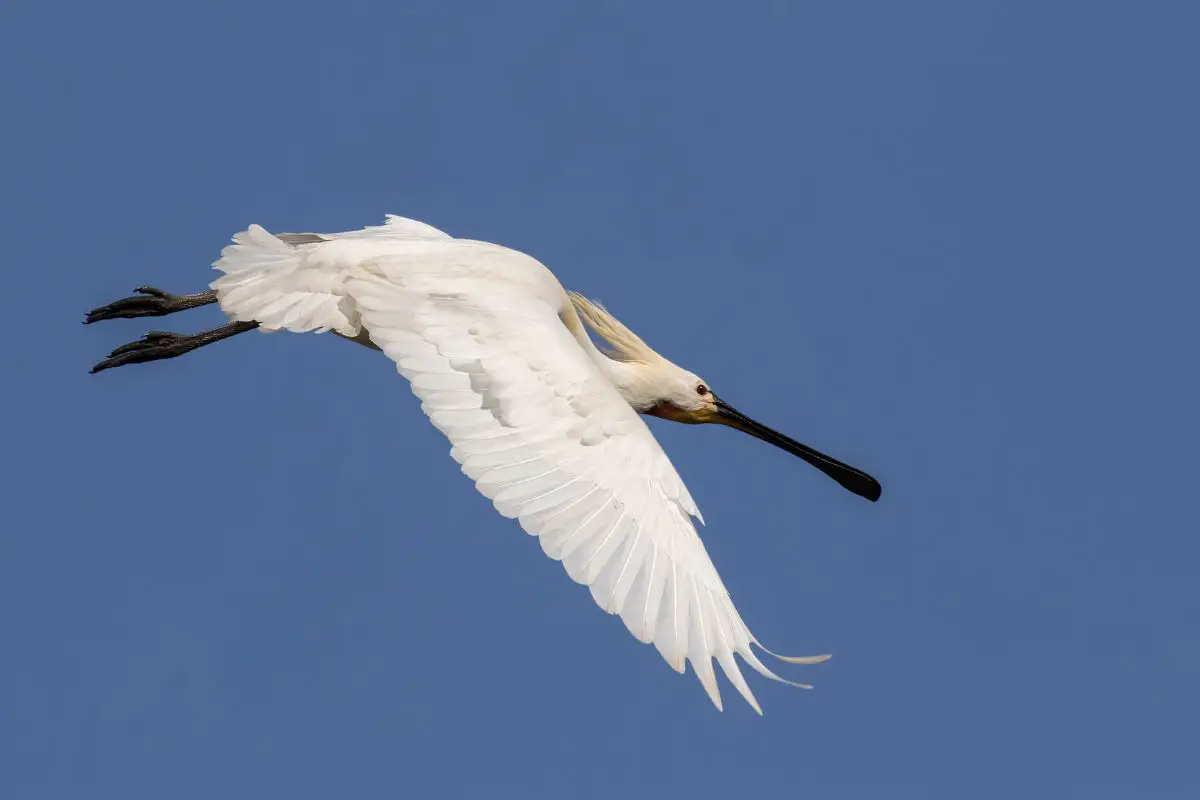
The next bird on our list is the Eurasian spoonbill. These birds are found in Africa, Europe, and Asia. They get their name from their large bill which is shaped like a spoon!
These bills help them to find food in the water.
What Does A Eurasian Spoonbill Look Like?
Eurasian spoonbills are white with a black tip on their bill. They have long legs and webbed feet to help them move through the water. Their wings are broad and they have a long neck.
These birds can grow to be about 3 feet tall!
What is the Eurasian Spoonbill’s habitat?
Eurasian spoonbills live in shallow waters near the coast. They build their nests in trees or bushes near the water.
What is the Eurasian Spoonbill’s diet?
Eurasian spoonbills eat small fish, crustaceans, and insects. They use their bill to filter food out of the water.
How Does a Eurasian Spoonbill Reproduce?
Eurasian spoonbills mate for life. They build their nests out of sticks and twigs near the water. The female lays 2-5 eggs in the nest.
Both parents help to care for the young chicks.
What is the Eurasian Spoonbill’s lifespan?
The Eurasian spoonbill has a lifespan of about 15 years.
What are the Eurasian Spoonbill’s predators?
The Eurasian spoonbill’s predators include red foxes.
3. American White Ibis

Next up, we have the American white ibis. This bird is found in North and South America and is most commonly known for its white plumage and long, curved bill. The American white ibis is a wading bird that spends most of its time in marshes and wetlands.
What Does An American White Ibis Look Like?
The American white ibis is a medium-sized bird with a wingspan of around 3.3 feet. The body is mostly white with some black on the tips of the wings. The bill is long and curved, and the legs are black.
What is the American White Ibis’ habitat?
The American white ibis is found in marshes and wetlands.
What is the American White Ibis’ diet?
The American white ibis feeds on insects, crustaceans, and small vertebrates.
How Does an American White Ibis Reproduce?
The American white ibis mates for life. The female lays 2-3 eggs in a nest made of sticks and vegetation. She incubates the eggs for about 24 days.
The chicks are born altricial, meaning they are born blind and naked. They are cared for by both parents and fledge at around 6 weeks old.
What is the American White Ibis’ lifespan?
The American white ibis lives for around 20 years in the wild.
What are the American White Ibis’ predators?
The American white ibis’ predators include humans, dogs, cats, and coyotes.
4. Black-Crowned Night Heron?
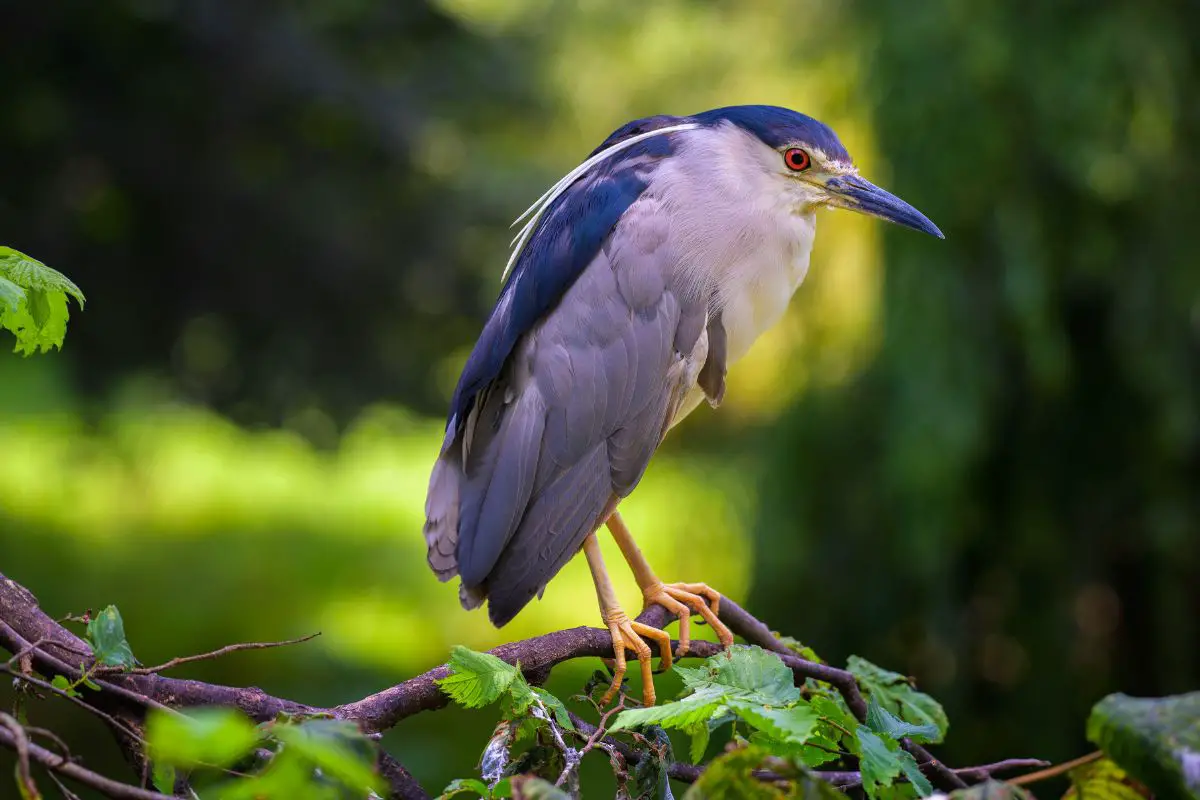
Now, let’s talk about the Black-Crowned Night Heron! These birds are pretty small compared to other herons, but don’t let that deceive you – they’re incredibly fierce predators.
What Does A Black-Crowned Night Heron Look Like?
They have a shaggy black crown and back, with white underparts. Their legs are short and yellow, and they have a long, sharp beak.
What is the Black-Crowned Night Heron’s habitat?
Black-Crowned Night Herons are found in marshes, swamps, and wet meadows.
What is the Black-Crowned Night Heron’s diet?
Their diet consists mostly of small fish, but they will also eat amphibians, reptiles, small mammals, and insects.
How Does a Black-Crowned Night Heron Reproduce?
These herons mate for life, and they build their nests in trees near water. Both parents help to incubate the eggs and care for the young.
What is the Black-Crowned Night Heron’s lifespan?
The average lifespan of a Black-Crowned Night Heron is 10 to 12 years.
What are the Black-Crowned Night Heron’s predators?
The main predators of Black-Crowned Night Herons are raccoons, owls, and other birds of prey.
5. What is a Great Egret?
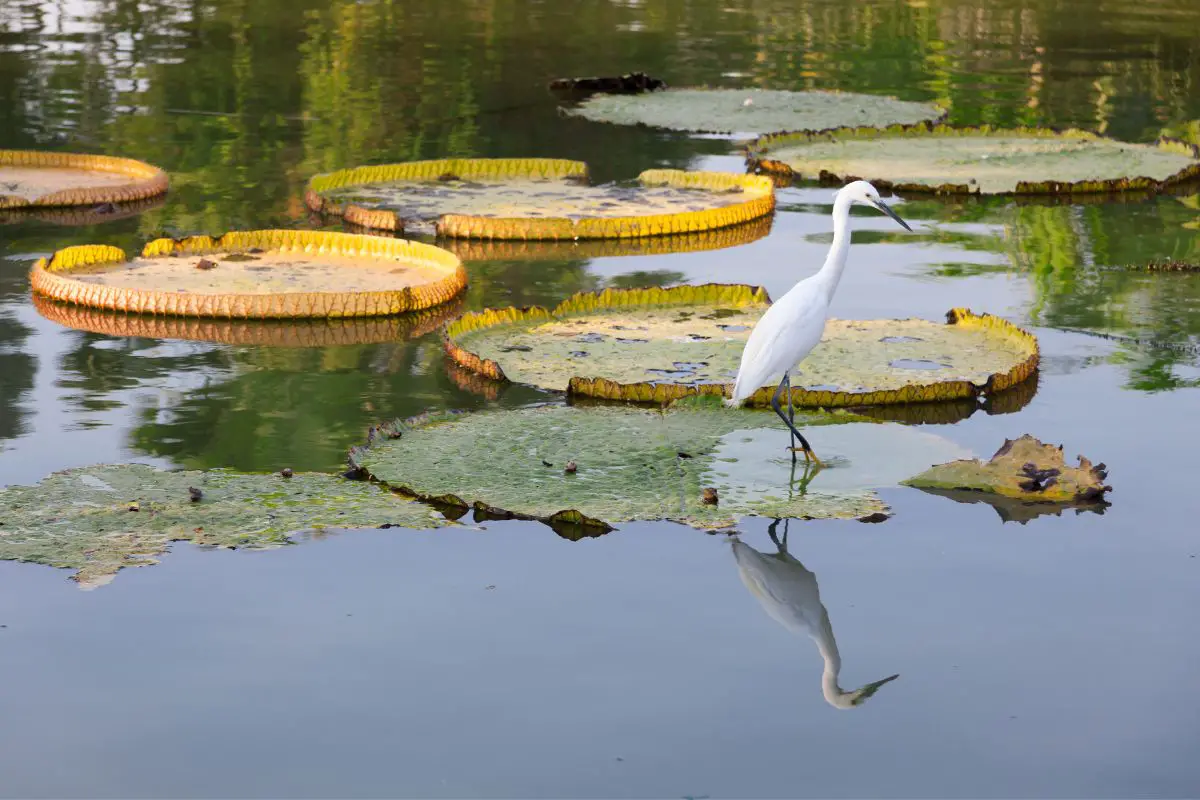
The Great Egret is a large wading bird in the heron family. Great Egrets are distributed throughout the Americas, from southern Canada to Tierra del Fuego. A member of the heron family, it is closely related to other large white egrets such as the Snowy Egret and the Little Egret.
The Great Egret was once hunted for its plumes, which were used to decorate hats and clothing. This hunting led to a decline in populations, but conservation efforts have helped the species to recover. The Great Egret is also the symbol of the National Audubon Society, an organization dedicated to the conservation of birds and their habitats.
The Great Egret is one of the most widespread and familiar egrets in the world. It occurs on all continents except Antarctica.
What Does A Great Egret Look Like?
The Great Egret is a large bird, measuring 101–137 cm (40–54 in) in length and weighing 1.5–3 kg (3.3–6.6 lb). They have a wingspan of 131–170 cm (52–67 in). The Great Egret is entirely white, and like all egrets it has long, thin legs and a long S-shaped neck.
The bill is yellowish-orange and is somewhat heavier and longer than that of the Little Egret. Sexes are similar in appearance, although the males are generally larger than the females and have a slightly longer bill. The Great Egret is not as closely related to the Great White Egret of Africa and Eurasia, as was once believed.
These two species were previously placed in the same genus, Egretta, but DNA evidence suggests that they are not as closely related as was thought.
What is the Great Egret’s habitat?
The Great Egret is a wading bird, meaning it lives near water and uses its long legs to wade through shallow water in search of fish, amphibians, reptiles, and insects. Great Egrets are found in wetlands all over the world, including marshes, swamps, lakes, and rivers. They are also found in dryer habitats such as grasslands, deserts, and even urban areas.
What is the Great Egret’s diet?
Great Egrets are opportunistic feeders, meaning they will eat whatever food is most readily available. Their diet consists of fish, amphibians, reptiles, and invertebrates. Great Egrets use their long necks and sharp bills to capture their prey.
They will often stand still in shallow water, waiting for their prey to come close enough to strike.
How Does a Great Egret Reproduce?
Great Egrets reproduce by building nests in trees, shrubs, or reed beds. Both the male and female help to build the nest, which is a platform of sticks lined with leaves. The female usually lays 3–5 eggs, which are incubated for about 28 days.
Both parents help to feed the chicks, which fledge (leave the nest) after about 6–8 weeks.
What is the Great Egret’s lifespan?
The Great Egret has a lifespan of 10–25 years in the wild.
What are the Great Egret’s predators?
The Great Egret’s predators include birds of prey such as hawks and eagles, and mammals such as raccoons and opossums.
6. Cattle Egret
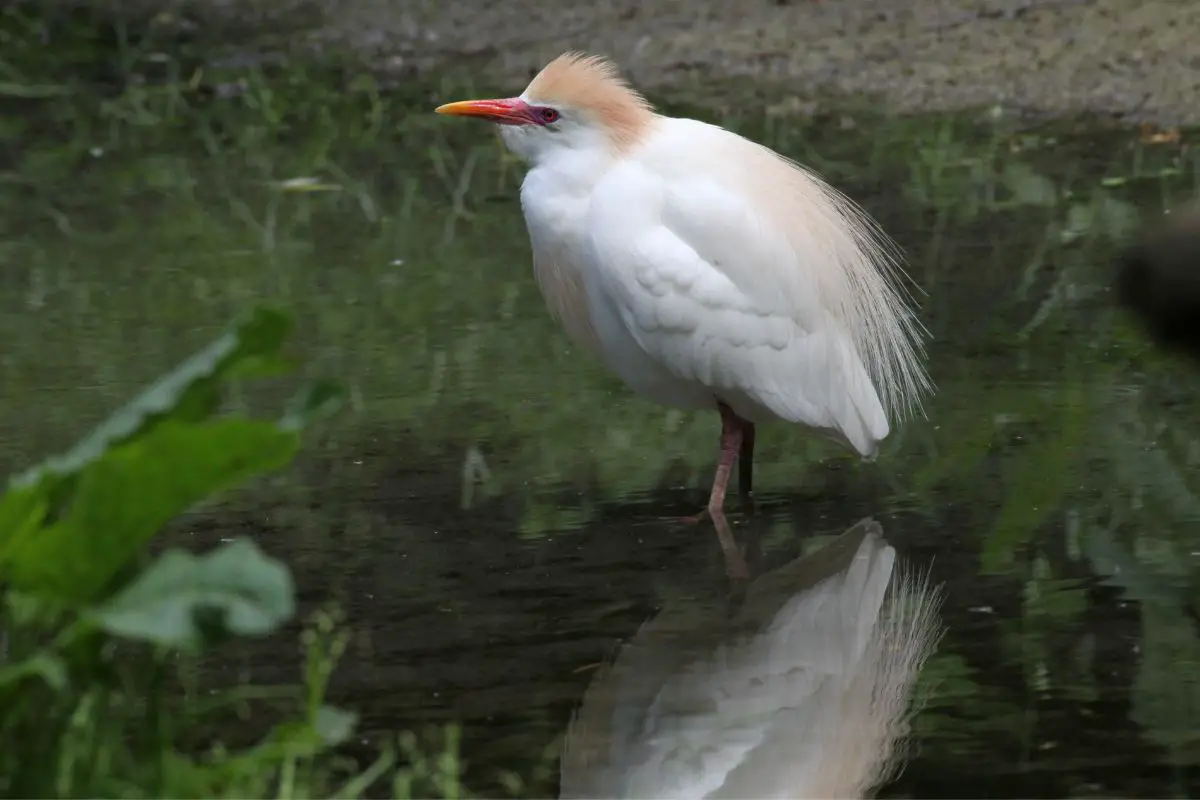
Now we turn to the Old World for our next species, the cattle egret. The name says it all with this one as they are often seen in close association with large grazing animals such as cows, hence why they are also known as ‘cowbirds’. In fact, these birds will often follow herds of animals around, feeding on the insects that are disturbed by the animals’ movement.
Interestingly, while they will form small flocks at roosts and during their breeding season, cattle egrets are generally solitary birds when feeding. So, if you see one near some cows, chances are there won’t be too many others around!
What Does A Cattle Egret Look Like?
As their name suggests, cattle egrets are fairly small birds when compared to other crane species. They stand at around 22-24 inches tall and have a wingspan of between 39 and 41 inches. Their plumage is primarily white, with some yellowish or orange feathers on their head, neck and breast.
They also have long, thin legs that are either yellow or orange in color.
What is the Cattle Egret’s habitat?
Cattle egrets are found in a variety of habitats including grasslands, marshes, woodlands and even desert areas. However, they seem to prefer open areas where there is plenty of space for them to forage. These birds are also highly adaptable and can be found in both rural and urban areas, as long as there are some large animals around for them to follow!
What is the Cattle Egret’s diet?
As we mentioned before, cattle egrets primarily feed on insects. These can be anything from beetles and grasshoppers to crickets and dragonflies. They will also eat other small prey items such as spiders, lizards, snakes and even rodents on occasion.
How Does a Cattle Egret Reproduce?
Cattle egrets generally breeding during the spring and summer months. They will build their nests in trees, bushes or reed beds close to water. These birds usually lay between three and five eggs, which are incubated by both parents for around 23-26 days.
The chicks will fledge (leave the nest) after around six weeks, but they will continue to be cared for by their parents for some time after that.
What is the Cattle Egret’s lifespan?
The average lifespan of a cattle egret in the wild is around 10 years. However, some individuals have been known to live for up to 20 years!
What are the Cattle Egret’s predators?
As with most crane species, the main predators of cattle egrets are large birds of prey such as eagles and hawks. These birds will often target eggs and young chicks, although adults are also at risk of being attacked. Other predators of these birds include snakes, foxes, raccoons and even some mammals such as weasels and mongooses.
7. Reddish Egret
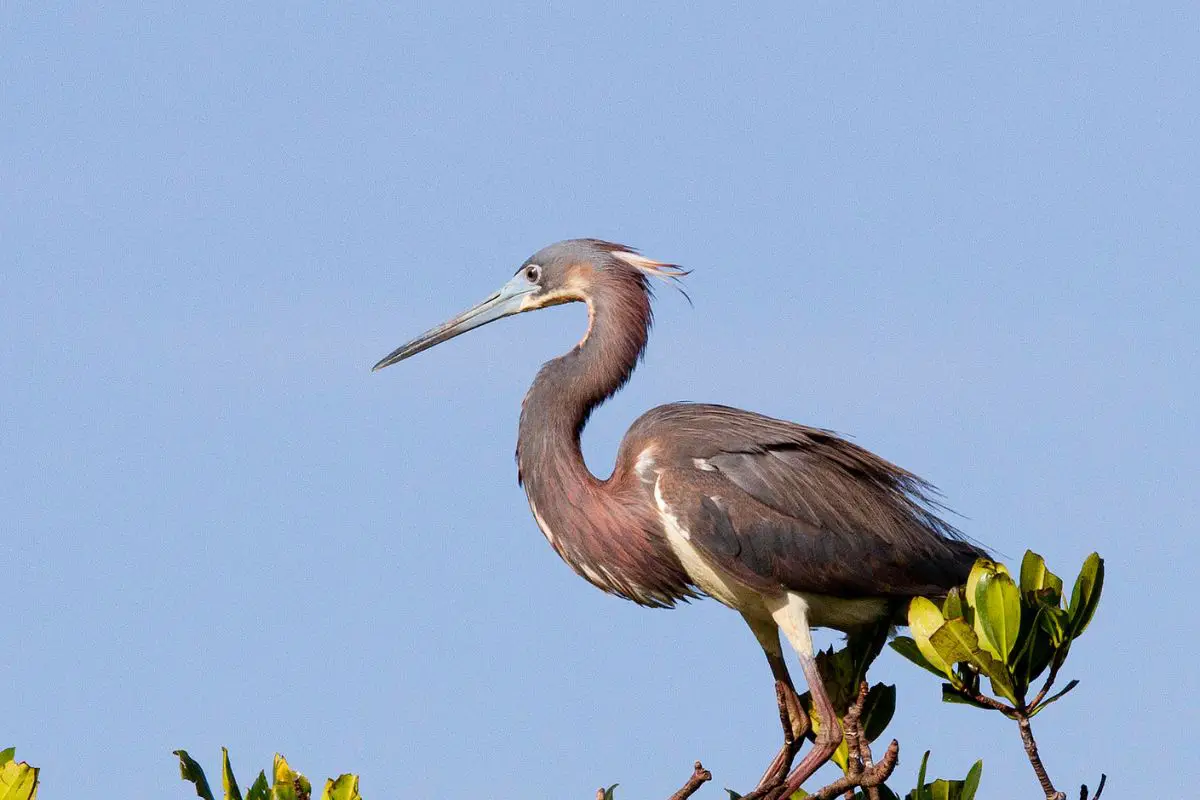
Staying in the Egret family, we now come to the reddish egret. This is a medium-sized bird that is found in coastal areas of North and South America. Reddish egrets get their name from their distinctive plumage, which ranges in color from pale gray to rich chestnut brown.
Their neck and breast are usually a paler color than their back and wings, and they have long, thin legs that are either yellow or orange in color.
What Does a Reddish Egret Look Like?
Reddish egrets are fairly small birds when compared to other crane species. They stand at around 24-28 inches tall and have a wingspan of between 39 and 41 inches. Their bill is relatively long and thin, and their plumage is very distinctive.
As we mentioned above, the color of their feathers can range from pale gray to rich chestnut brown, and they often have patches of white on their wings and tail. Reddish egrets are also known for their “hunting dance”. When they spot prey, they will start to move back and forth in a distinctive manner, flapping their wings and lifting their feet off the ground.
This is thought to help them attract attention to themselves so that they can catch more food.
What is the Reddish Egret’s habitat?
Reddish egrets are found in coastal areas of North and South America. In the United States, they are commonly seen in states such as Florida, Louisiana, and Texas. They prefer to live in areas where there is a lot of water, such as marshes, swamps, and mangrove forests.
They will also sometimes inhabit lagoons, river deltas, and coastal areas. Reddish egrets are known to be fairly shy birds, and they will often avoid areas where there are humans.
What is the Reddish Egret’s diet?
Reddish egrets mainly eat fish, but they will also occasionally eat amphibians, reptiles, small mammals, and invertebrates. They will often wait patiently at the water’s edge for their prey to swim by, and they will then strike out with their long bills to catch it. They have been known to wade into the water in order to catch fish, and they will sometimes even dive underwater in search of food.
How Does a Reddish Egret Reproduce?
Reddish egrets reach sexual maturity at around 3 years of age. They will typically mate for life, and they will build their nests in areas where there is a lot of water. The female will lay between two and four eggs per clutch, and she will incubate them for around 28 days.
Both parents will help to care for the young birds once they hatch.
What is the Reddish Egret’s lifespan?
The average lifespan of a reddish egret is around 10 years, although some birds have been known to live for up to 15 years in captivity.
What are the Reddish Egret’s predators?
The main predators of reddish egrets are large birds of prey, such as eagles and hawks. They will also sometimes fall prey to mammals such as foxes, raccoons, and otters. Humans are also a significant threat to these birds, as they are often killed for their feathers.
This used to be a very common practice, but it is now illegal in many countries.
8. Snowy Egret
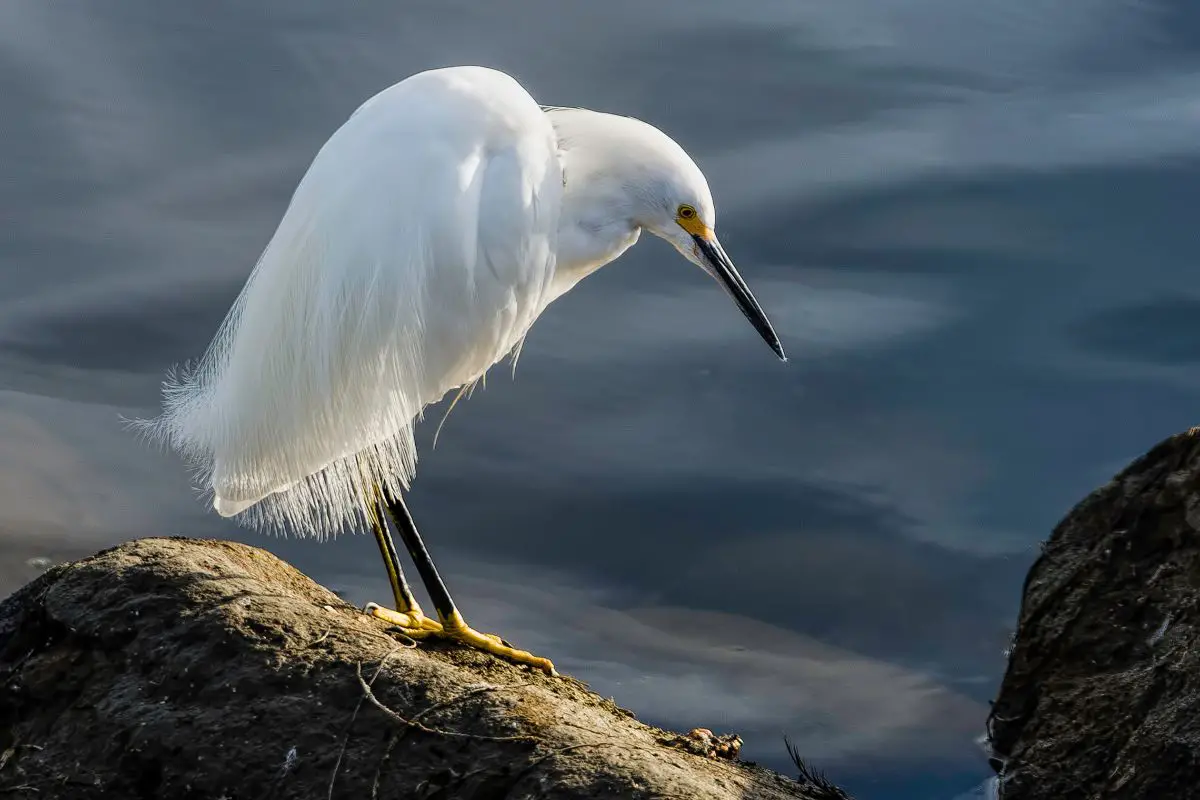
The last egret on our list is the snowy egret. This is a small white bird that is found in parts of North and South America, as well as Africa, Asia, and Australia. Snowy egrets get their name from their plumage, which is bright white all over.
They have long, thin legs that are yellow in color, and their bill is black with a yellow tip.
What Does A Snowy Egret Look Like?
Snowy egrets are small birds, measuring just 24-28 inches in length. They have a wingspan of 39-41 inches, and they weigh between 10-15 ounces. As we mentioned before, these birds are pure white all over.
Their long legs are thin and yellow, and their bill is black with a yellow tip. Their eyes are dark brown.
What is the Snowy Egret’s habitat?
Snowy egrets can be found in a variety of habitats, including freshwater marshes, coastal wetlands, and mangrove forests. They often build their nests in trees or bushes near water. These birds are found in parts of North and South America, as well as Africa, Asia, and Australia.
What is the Snowy Egret’s diet?
Snowy egrets are opportunistic feeders, which means that they will eat whatever food is available to them. Their diet includes fish, amphibians, reptiles, insects, and crustaceans. To catch their prey, these birds will either wade in the water or stand still and wait for an animal to come within range.
They will then strike quickly to catch their prey.
How Does a Snowy Egret Reproduce?
Snowy egrets reproduce by building nests in trees or bushes near water. Both the male and female will help to build the nest, which is made of sticks, leaves, and grass. The female will lay 2-5 eggs in the nest, and both parents will take turns incubating them.
The chicks hatch after 21-25 days, and they fledge (grow their feathers) at around 6-7 weeks old.
What is the Snowy Egret’s lifespan?
The average lifespan of a snowy egret is 10-15 years in the wild. In captivity, they can live for up to 20 years.
What are the Snowy Egret’s predators?
The main predators of snowy egrets are large birds of prey, such as bald eagles and great horned owls. These birds will sometimes steal eggs or small chicks from the nest. Adult snowy egrets can also be killed by alligators, crocodiles, and snakes.
9. Greater Flamingo
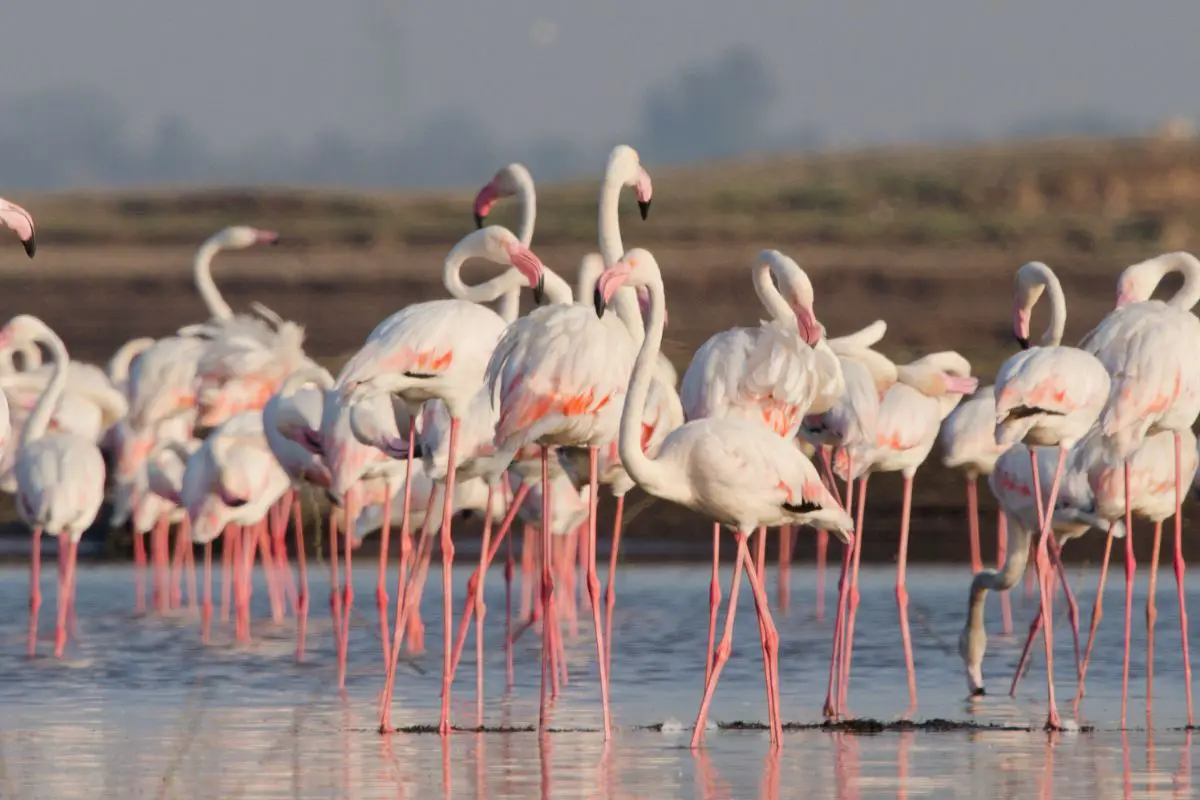
Let’s move on to the greater flamingo. The greater flamingo is the largest species of flamingo, and it is found in Africa, southern Europe, the Middle East, and India. Greater flamingos are social birds, and they live in flocks of up to 100 birds.
They are also known to form mixed flocks with other species of flamingos. They are migratory birds, and they travel in large flocks. Greater flamingos are interesting birds because of their unique appearance and their social behavior.
If you ever have the chance to see one in person, be sure to take the time to appreciate these beautiful creatures.
What Does a Greater Flamingo Look Like?
Greater flamingos are large birds, measuring 4-5 feet in length. They have a wingspan of 6-7 feet. Their long necks and stilt-like legs give them a height of up to 5 feet when they are standing on their legs.
When they are swimming, their necks and legs fold in, and they look more like ducks. Greater flamingos are easily recognizable thanks to their long necks, stilt-like legs, and pink plumage. Their wings are black with white stripes, and they have a black band around their neck.
Their legs are long and thin, and their feet are webbed. Their plumage gets its pink color from the beta-carotene that they consume. This pigment is found in the algae and crustaceans that make up their diet.
What is the Greater Flamingo’s habitat?
Greater flamingos are found in Africa, southern Europe, the Middle East, and India. They prefer salt water lakes and estuaries. They build their nests on mudflats, and they roost in trees or on cliffs.
What is the Greater Flamingo’s diet?
Greater flamingos eat algae and crustaceans. Their diet gives them their pink plumage. They use their long necks and curved bills to filter food from the water.
How Does a Greater Flamingo Reproduce?
Greater flamingos reproduce by building nests on mudflats. They lay 2-3 eggs in each nest, and the eggs hatch after 28 days. The chicks are born with white plumage, and they gradually turn pink as they mature.
What is the Greater Flamingo’s lifespan?
The greater flamingo has a lifespan of 20-30 years in the wild.
What are the Greater Flamingo’s predators?
The main predators of the greater flamingo are humans, who hunt them for their meat and feathers. Other predators include birds of prey and large mammals such as lions and hyenas.
10. Great Blue Heron
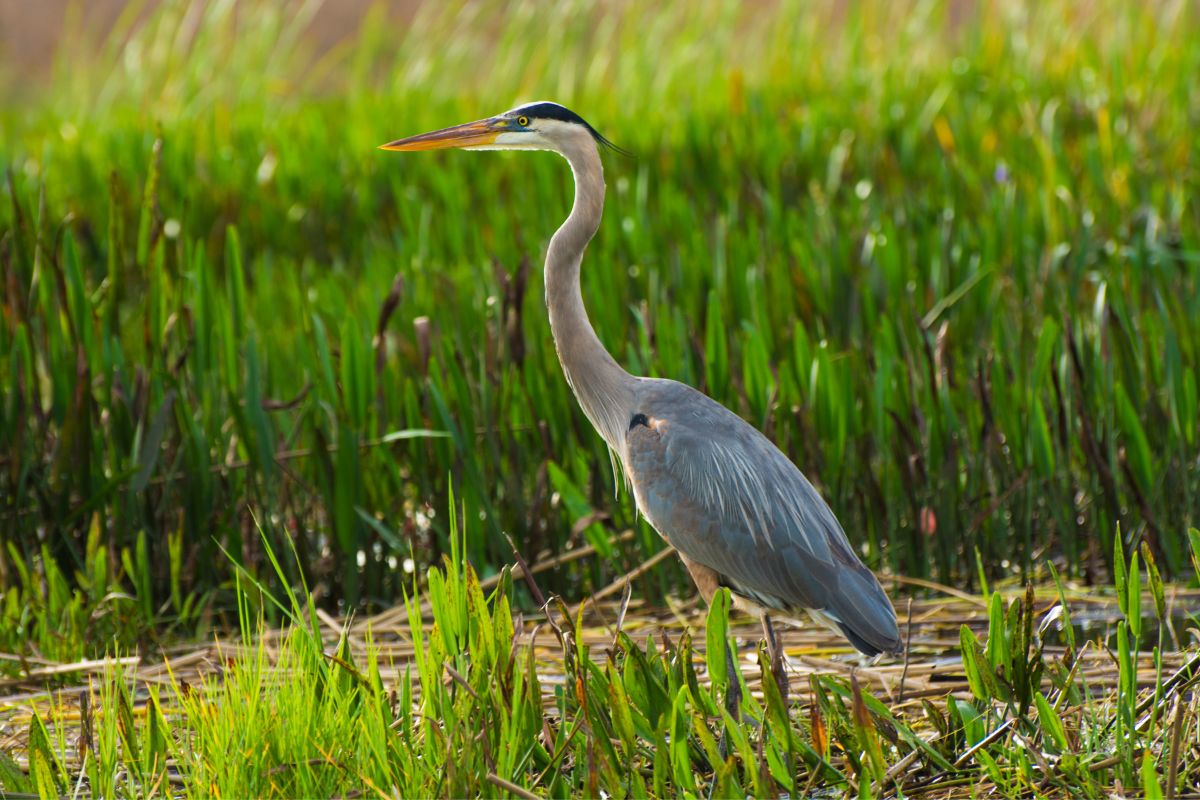
Now let’s talk about the Great Blue Heron! These massive birds can reach up to four feet in height and have a wingspan of six and a half feet. They are one of the most easily recognizable wading birds, with their long necks, large grey-blue bodies and black legs.
What Does A Great Blue Heron Look Like?
The Great Blue Heron is a large, grey-blue bird with a long neck, black legs and yellow feet. They have a long, pointed beak which they use to catch fish. Their wings are broad and rounded, and they have a distinctive “kuk-kuk-kuk” call.
What is the Great Blue Heron’s habitat?
Great Blue Herons are found near freshwater marshes, ponds and lakes across North and Central America. When they hunt, they stand still at the water’s edge or wade through the shallows, waiting to strike at fish with their sharp beaks.
What is the Great Blue Heron’s diet?
Great Blue Herons are carnivores, which means that they eat other animals. Their diet consists mostly of fish, but they will also eat amphibians, reptiles, small mammals and birds.
How Does a Great Blue Heron Reproduce?
Great Blue Herons mate for life, and they build large nests in trees near water. The female lays 3-5 eggs, which hatch after about 28 days. The chicks are cared for by both parents and fledge (leave the nest) after about 60 days.
What is the Great Blue Heron’s lifespan?
The average lifespan of a Great Blue Heron is 10-12 years, but they can live up to 20 years in captivity.
What are the Great Blue Heron’s predators?
The main predators of Great Blue Herons are mammals such as raccoons, skunks, and foxes.
11. Grey Heron
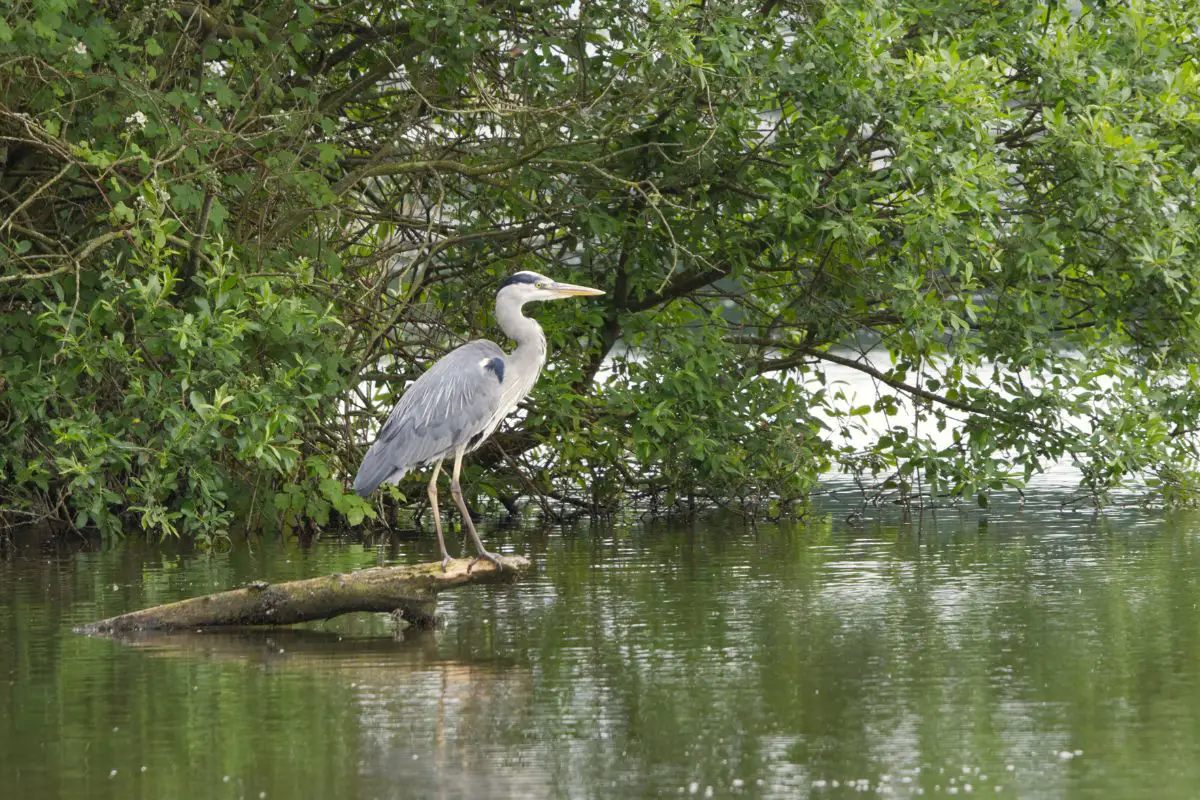
Staying in the heron family, let’s now learn about the Grey Heron! These birds are slightly smaller than Great Blue Herons, but they are just as easily recognizable thanks to their long necks and grey plumage.
What Does a Grey Heron Look Like?
Grey herons are large birds with long necks and grey plumage. They have black legs and yellow feet, and their bills are grey with a black tip. Juvenile birds are browner in colour and have duller plumage.
What is the Grey Heron’s habitat?
Grey herons are found in wetlands all over Europe, Asia, and Africa. They prefer shallow water where there is plenty of fish to eat.
What is the Grey Heron’s diet?
Grey herons are predators, and their diet consists mainly of fish. They will also eat amphibians, reptiles, small mammals, and insects.
Grey herons are expert hunters! They stand very still at the edge of a body of water, waiting for fish to swim by. When they see their prey, they strike quickly with their long necks and sharp bills.
How Does a Grey Heron Reproduce?
Grey herons reproduce in colonies, and they build their nests in trees close to water. The female lays 3-5 eggs, which are incubated for 26-30 days. Both parents help to raise the young birds.
What is the Grey Heron’s lifespan?
The average lifespan of a grey heron is 15 years, but some birds have been known to live for up to 25 years.
What are the predators of the Grey Heron?
The main predators of grey herons are large mammals such as foxes, cats, and dogs. Birds of prey such as eagles and hawks will also prey on young herons.
12. Tricolored Heron
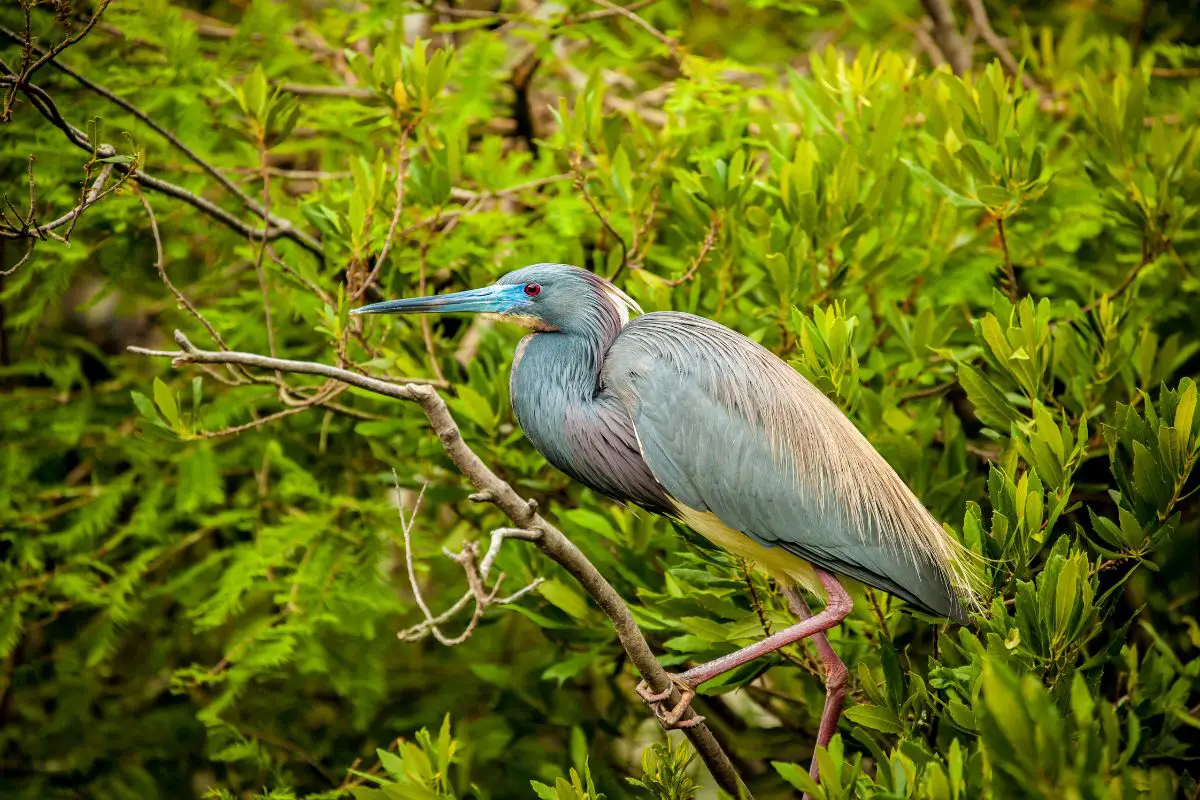
Another type of heron, the Tricolored Heron is a beautiful bird with blue-grey plumage and white underparts. These birds are found in marshes and wetlands all over North and South America.
What Does a Tricolored Heron Look Like?
Tricolored herons are large birds with blue-grey plumage and white underparts. They have long necks and legs, and their bills are yellow with a black tip. These birds are named for their distinctive coloration; the upperparts are blue-grey, while the underparts are white.
The wings are also blue-grey, with black tips. The bill is yellow with a black tip, and the legs are yellow. Tricolored herons are typically about 28 inches long, with a wingspan of around 4 feet.
They weigh between 2 and 3 pounds.
What is the Tricolored Heron’s habitat?
Tricolored herons are found in marshes and wetlands all over North and South America. In the United States, they are found along the Gulf Coast, as well as in parts of the Midwest and Northeast. These birds typically nest in trees near water.
However, they will also nest on the ground if there are no suitable trees available.
What is the Tricolored Heron’s diet?
Tricolored herons primarily eat fish, but they will also eat amphibians, reptiles, crustaceans, and insects. These birds use their long necks and bills to reach into the water to catch fish. They will also wade through shallow water in search of food.
How Does a Tricolored Heron Reproduce?
Tricolored herons typically mate for life. The nesting season begins in late spring, and the birds will build a large nest out of sticks and twigs. The female will lay 3-5 eggs, which will hatch after about 3 weeks.
After the chicks hatch, both parents will care for them. The chicks will fledge (grow their feathers and learn to fly) after about 6-8 weeks.
What is the Tricolored Heron’s lifespan?
Tricolored herons can live for up to 20 years in the wild.
What are the Tricolored Heron’s predators?
Tricolored herons have a few predators, including raccoons, owls, and snakes. However, their main predator is humans. These birds are often killed for sport or for their feathers, which are used in crafts such as fly-fishing lures.
Humans are also responsible for destroying the wetlands that these birds rely on for food and shelter. Wetland development and pollution are the biggest threats to the Tricolored Heron’s survival.
13. Yellow-Crowned Night Heron
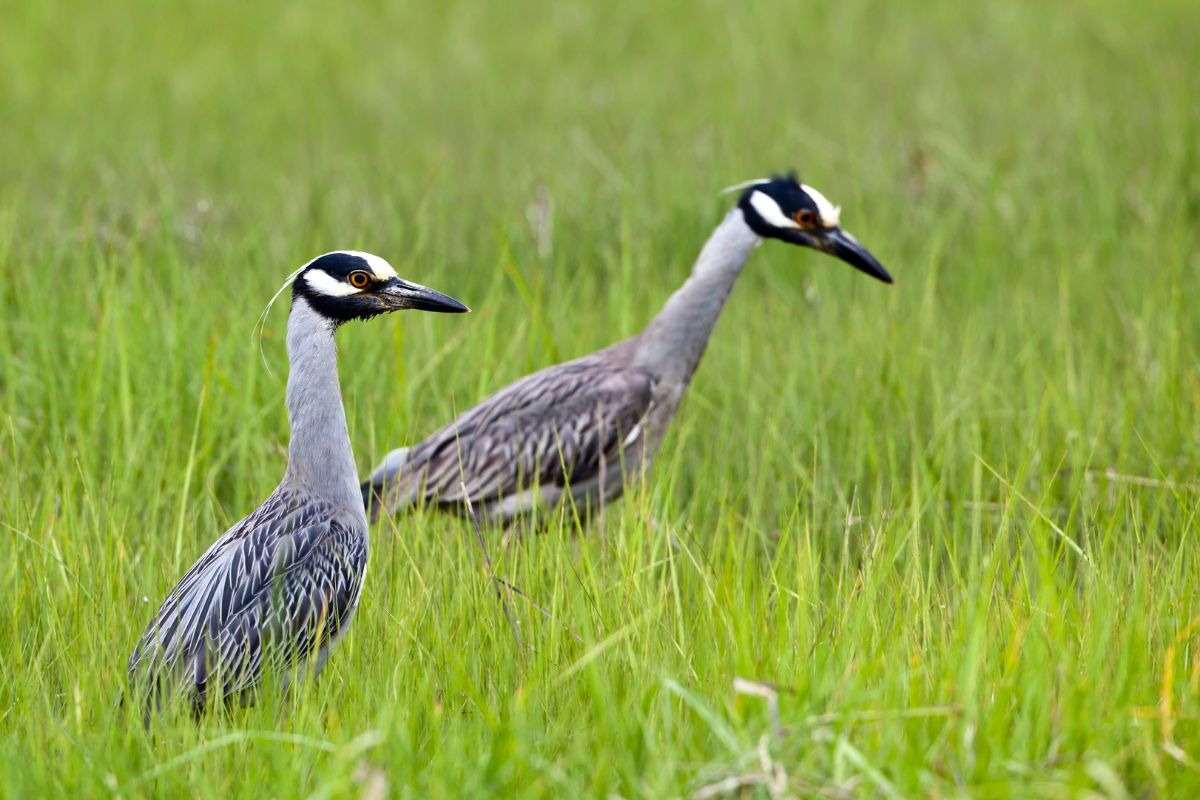
Finally, the last type of heron on our list is the Yellow-Crowned Night Heron. These nocturnal birds are found in marshes and wetlands all over the world.
What Does a Yellow-Crowned Night Heron Look Like?
Yellow-crowned night herons are small to medium-sized birds with dark grey or black upperparts and light grey to white underparts. They have a distinctive yellow patch on their heads, which is where they get their name. These herons have red eyes and long, sharp beaks that they use to catch fish, crabs, and other small prey.
They have long legs that are perfect for wading through water in search of food. Yellow-crowned night herons are usually quite shy birds, but they will sometimes form small flocks when feeding.
What is the Yellow-Crowned Night Heron’s habitat?
As their name suggests, yellow-crowned night herons are most active at night. During the day, they roost in trees or bushes near water. These herons are found in marshes, wetlands, and other habitats with plenty of water and vegetation.
They are often seen wading through shallow water in search of food.
What is the Yellow-Crowned Night Heron’s diet?
As you might expect from a bird that lives near water, the yellow-crowned night heron’s diet consists mainly of fish. They will also eat crabs, frogs, snakes, and other small prey. These herons use their sharp beaks to spear their prey before swallowing it whole.
How Does a Yellow-Crowned Night Heron Reproduce?
Yellow-crowned night herons nests in trees or bushes near water. They build their nests out of sticks and twigs, and line them with leaves.
These herons usually lay 2-6 eggs per clutch. The female incubates the eggs for about 24 days before they hatch. Both parents help to raise the young birds, which fledge (leave the nest) after about 4-6 weeks.
What is the Yellow-Crowned Night Heron’s lifespan?
In the wild, yellow-crowned night herons can live for up to 15 years.
What are the Yellow-Crowned Night Heron’s predators?
The main predators of yellow-crowned night herons are other birds, such as owls and eagles. These birds of prey will swoop down and snatch the herons from the air. Humans are also a threat to these herons, as they are sometimes hunted for food or their feathers.
14. Trumpeter Swan
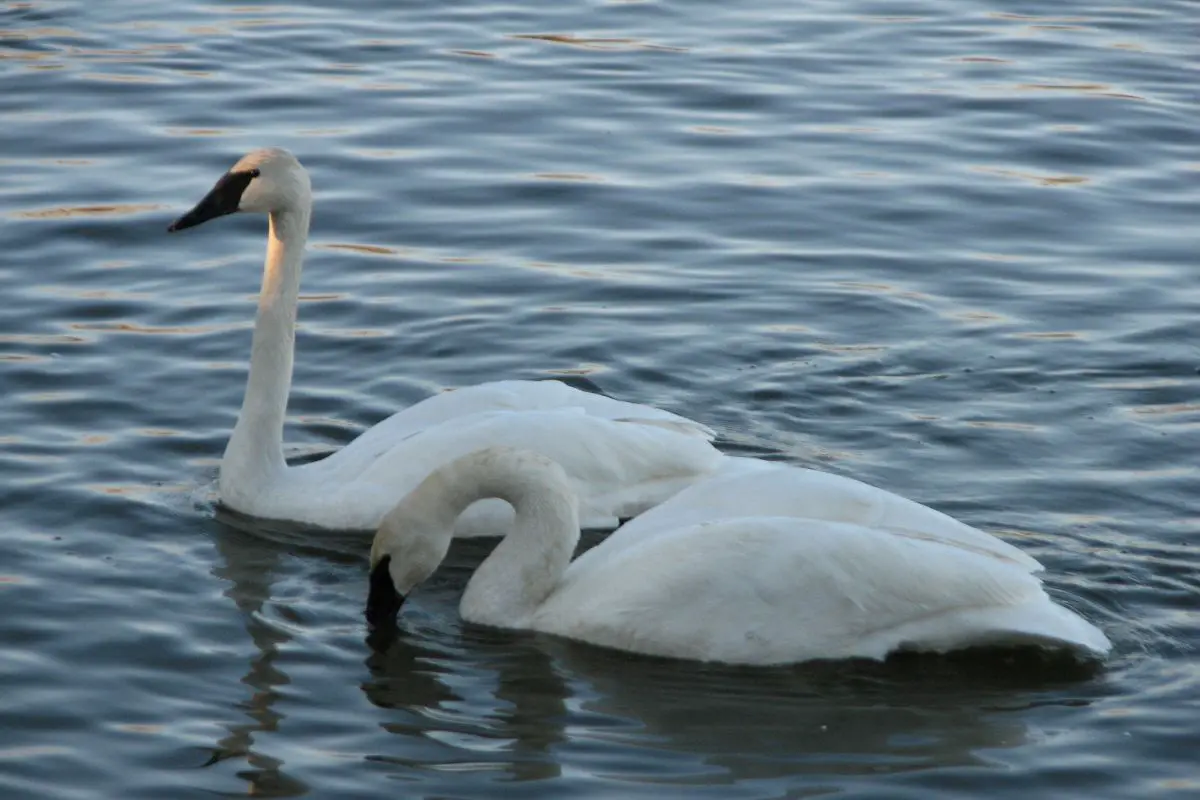
The trumpeter swan is the largest North American waterfowl. These birds can weigh up to 30 pounds and have a wingspan of up to 7 feet.
What Does a Trumpeter Swan Look Like?
Trumpeter swans are large birds, with a body length of up to 6 feet (1.8 meters) and a wingspan. They have black bills and legs, and their eyes are a deep red.
These waterfowl are often mistaken for mute swans, which are also large, white, and found in North America. However, mute swans have black bills and legs, whereas trumpeter swans have black bills with a yellow stripe down the middle.
What is the Trumpeter Swan’s Habitat?
Trumpeter swans live in North America and Canada. They prefer to live in open wetlands such as marshes and lakes.
What is the Trumpeter Swan’s Diet?
The trumpeter Swan’s diet consists mainly of aquatic plants, but they will also eat insects, small fish, and frogs. They use their long bills to search for food underwater.
How Does a Trumpeter Swan Reproduce?
Trumpeter swans mate for life. The female will lay 3-5 eggs in a nest made of aquatic plants. The eggs will hatch after about 34 days.
What is the Trumpeter Swan’s lifespan?
The trumpeter swan can live up to 20-25 years in the wild.
What are the Trumpeter Swan’s predators?
The main predators of trumpeter swans are humans, who hunted them for their meat and feathers. Other predators include wolves, coyotes, and foxes.
15. Limpkin
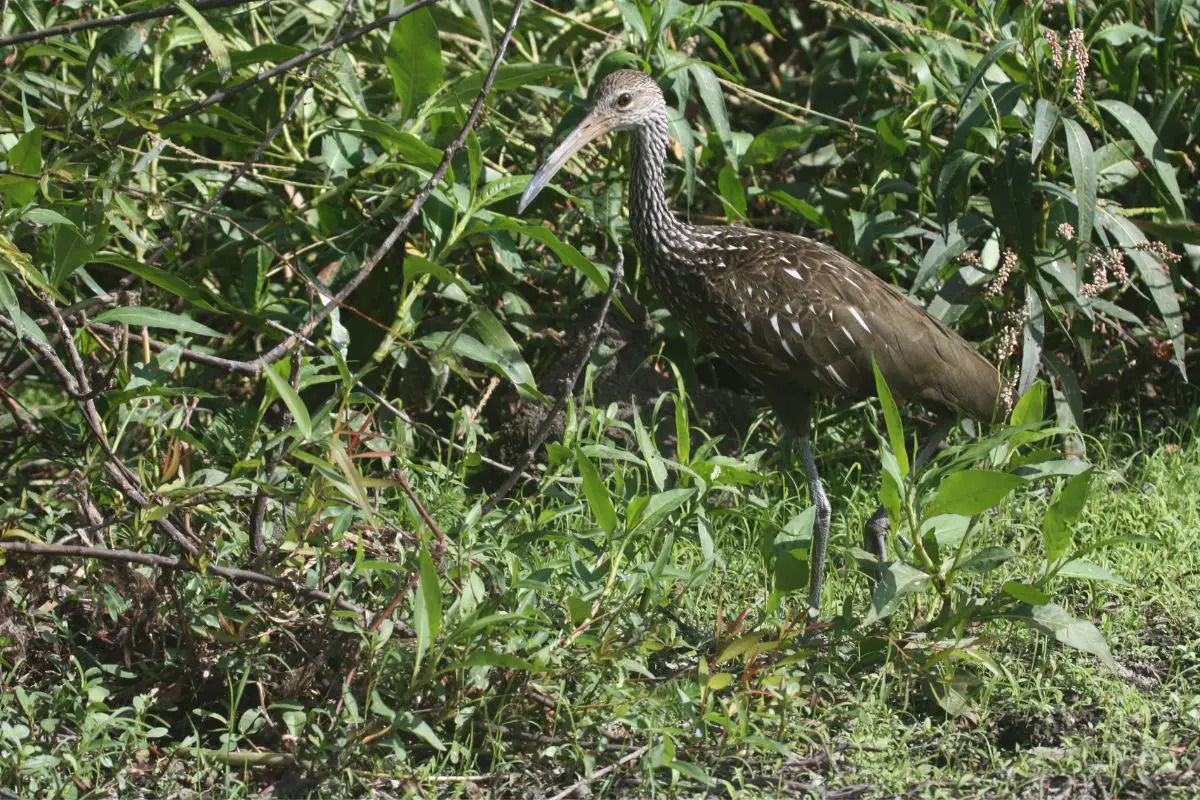
When it comes to limpkins, size does matter. These birds are the largest members of their family, with a body length of up to 3 feet (0.9 meters).
What Does a Limpkin Look Like?
Limpkins have long legs and necks, and they are often described as looking like a cross between a crane and a heron. They have reddish-brown plumage, and their bills are curved and slightly downward-pointing.
What is the Limpkin’s habitat?
The limpkin is a large wading bird that is found in the Americas. These birds are most commonly found in Florida, but they can also be found in other parts of the United States, Mexico, and Central America.
What is the Limpkin’s diet?
These birds primarily eat mollusks, but they will also occasionally eat frogs, insects, and small reptiles. When hunting, limpkins will use their long necks and bills to reach into the mud and water to find their prey.
How Does a Limpkin Reproduce?
Limpkins typically mate for life, and they build their nests in trees or bushes near water. These birds usually lay between 2 and 4 eggs at a time, and both parents help to incubate the eggs and care for the young chicks.
What is the Limpkin’s lifespan?
The average lifespan of a limpkin is 10 to 15 years.
What are the Limpkin’s predators?
The main predators of limpkins are alligators, snakes, and birds of prey.
16. Wood Stork
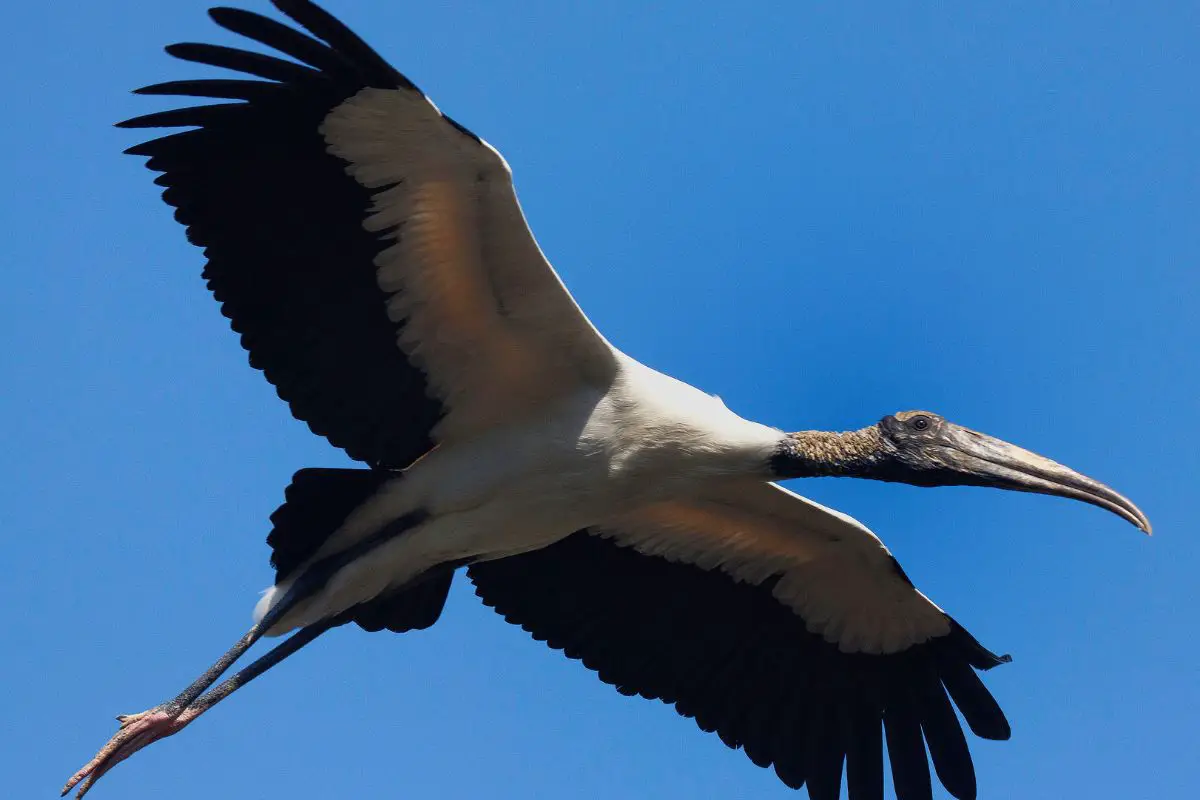
Ahh, storks. Despite the stories about them, these birds do not actually deliver babies. The wood stork is a large wading bird that is found in the Americas.
These birds are most commonly found in Florida, but they can also be found in other parts of the United States, Mexico, and Central America.
What Does A Wood Stork Look Like?
The wood stork is a large bird, with a wingspan of up to six feet. These birds are mostly white, with black feathers on their wings and tail. They have a long, curved bill that they use to help them find food.
These birds stand about three feet tall and weigh between four and eight pounds.
What is the Wood Stork’s habitat?
The wood stork is a bird that lives in wetlands. These birds can be found in swamps, marshes, and other wetland areas.
What is the Wood Stork’s diet?
The wood stork is a carnivorous bird, which means that they eat mostly meat. These birds use their long bills to help them find food i n the water. They eat fish, amphibians, reptiles, and invertebrates.
How Does a Wood Stork Reproduce?
The wood stork is a monogamous bird, which means that they mate with one partner for their lifetime.
These birds breed during the wet season. The female wood stork will build a nest out of sticks and leaves. She will lay two to five eggs in her nest.
The eggs will hatch after about 30 days. The chicks will stay in the nest for about two months before they learn to fly.
What is the Wood Stork’s lifespan?
The wood stork has a lifespan of about 20 years in the wild.
What are the Wood Stork’s predators?
The wood stork has a few predators, including alligators, snakes, and large birds of prey.
17. White Stork
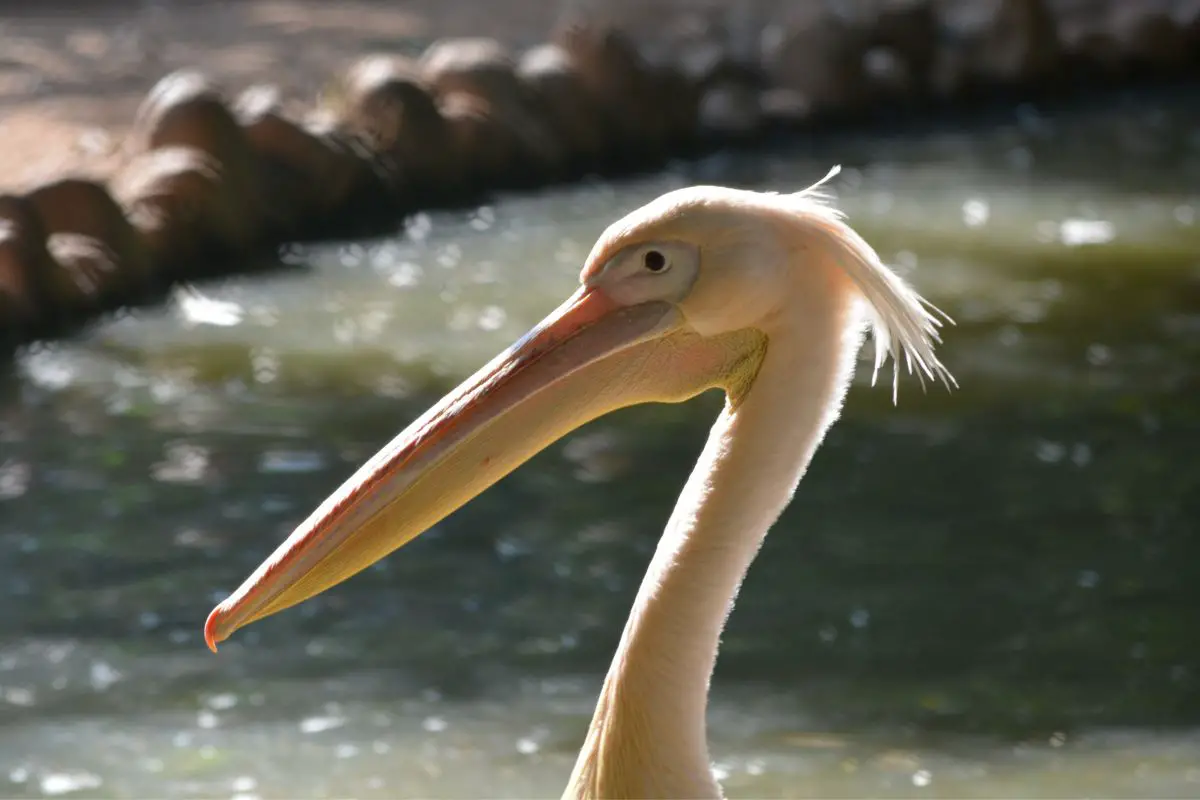
Last but not least, we have the white stork. The white stork is a protected species in many countries, and is considered to be a national symbol in some cultures. In Europe, it is estimated that there are between 20,000 to 30,000 pairs of white storks.
The white stork is a social bird, and can often be seen in groups of 10 or more. They are most active during the day, and their diet consists of small mammals, reptiles, and insects.
What Does a White Stork Look Like?
The white stork (Ciconia ciconia) is a large wading bird in the stork family. Its plumage is mainly white, with black on its wings. Adults have long red legs and long red bills, and pink legs.
They measure between 100-115 cm (3.3-3.9 ft) from beak to tail, with a wingspan of 2 m (6.6 ft), and can weigh up to 4 kg (8.8 lb). The white stork is a large bird, with a wingspan of up to seven feet. These birds are mostly white, with black feathers on their wings and tail.
They have a long, curved neck, and a long, pointed beak.
What is the White Stork’s habitat?
The white stork is a migratory bird, and can be found in Europe, Africa, and Asia. In Europe, they are found in countries like Spain, Portugal, and Greece. In Africa, they are found in countries like Morocco and Senegal.
In Asia, they can be found in countries like Kazakhstan and Mongolia.
What is the White Stork’s diet?
These birds feed on a variety of animals, including insects, reptiles, and small mammals. They will also eat carrion, which is the carcass of a dead animal.
How Does a White Stork Reproduce?
The white stork breeds between April and June. The female will lay two to six eggs in a nest, which is usually built in a tree. The incubation period is about 32 days, and the chicks will fledge (leave the nest) after about seven weeks.
What is the White Stork’s lifespan?
The white stork has a lifespan of about 20 to 30 years.
What are the White Stork’s predators?
The main predators of the white stork are humans and birds of prey, such as eagles and hawks.
